Plastic pollution is a global environmental issue that needs no introduction — the very words conjure images of plastic bags washed up along shorelines and floating lagoons of plastic debris choking out marine life. Microplastics, defined by the US National Oceanic and Atmospheric Administration as pieces of plastic that measure 5 millimeters or smaller, pose new threats due to their minute size and invisibility to the naked eye, but less is known about the damage they cause and how we can prevent it.
A single piece of clothing can release more than 1,900 microfibers in one wash, according to ecologist Mark Anthony Browne, which is why reducing your laundry’s pollution can help you drastically cut down on your waste. Washing machine filters and garment bags on the market claim to effectively trap synthetic microfibers before they enter sewage systems, but does the science support their claims? We tested the Guppyfriend Washing Bag and spoke to microfiber experts to see if it actually prevents microplastics from polluting your laundry routine.
A reusable garment bag for reducing pollution
The Guppyfriend Washing Bag is a durable garment bag that protects clothes from abrasive wear and tear in the washer and aids in trapping microplastic fibers that pollute wastewater. While it’s not a complete solution to the microplastics problem, Guppyfriend aims to reduce pollution and get you to think more carefully about how you do your laundry.
The presence of microplastics is ubiquitous from our drinking water to the belly of sea creatures, but even more pervasive are microplastic fibers, the largest marine pollutant in the world that enters waterways primarily from the shedding of synthetic fabric during laundering. Given that the average US household washes 300 loads of laundry per year, not including the commercial laundry sector, microfiber pollution adds up to a big problem.
According to Browne’s findings, sediment from shorelines around the world revealed that microfibers were present in quantities six times greater than plastic pollution, composing 85% of the human-made debris samples collected. The invisible strands of microfibers (both synthetic and natural) have infiltrated all major waterways from the poles to the Equator. The majority of microfiber pollution comes from the textile industry, where 60% of fabric for garments is made from plastic. Each time a garment is washed, some of its fibers break and shed, disappearing down the drain into public waterways.
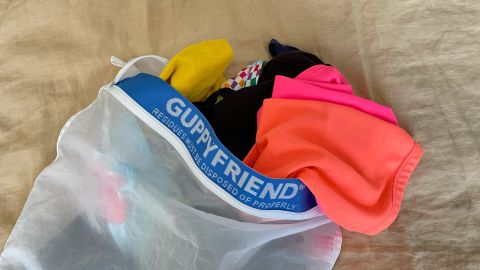
Launched in 2017, the Guppyfriend Washing Bag takes aim at reducing microplastic fiber pollution in home laundry care. Woven from a single continuous thread of untreated and undyed polyester, the bag’s fine mesh fabric allows water to thoroughly clean the garments held inside while it minimizes abrasion caused by the washing drum and captures shedded microfibers inside the corners of the zippered opening. Although the bag is made of synthetic material, its smooth monofilaments ensure that its own fibers remain intact. The Guppyfriend bag has undergone third party testing by the German Textile Research Centre North-West, DTNW, Fraunhofer Institute UMSICHT and the University of California at Santa Barbara as part of the Patagonia research program. Studies found that the washing bag served a double function: To retain broken fibers in the micrometer range through its mesh screen, and to reduce the textile abrasion of clothing caused in the washing drum by up to 86% under the experiment’s conditions.
Sturdy and easy-to-use design
The durable rectangular bag is a roomy 20 inches wide and 29 inches long, and is able to hold several items of clothing at a time. During testing, I was able to easily fit a pair of bike shorts, two pairs of leggings, and several undergarments in the bag — the equivalent of an extra small load of laundry — with enough space to move around. Households with multiple people or a substantial amount of workout clothes, outdoor gear and other synthetics would require more than one Guppyfriend bag.
The smooth mesh bag is transparent enough to see through yet feels sturdy thanks to tight weaving and a heavyweight band that wraps around the entire garment with tight double-stitching that holds it all together. The bag has a built-in loop to hang vertically or it can be folded flat and stored in a drawer.
I washed the bag five separate times to launder synthetic clothes and undergarments, using the delicate and cold water settings. After washing, the bag’s material was surprisingly dry from the spin cycle — no dripping wet bag to deal with. I simply removed the washed clothes to hang dry and put the bag back with my other laundry care products.
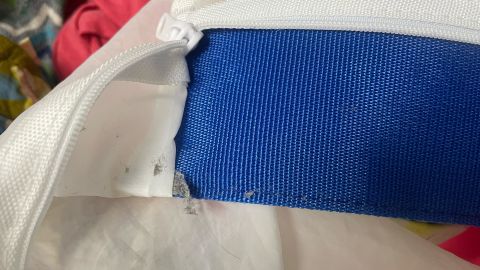
After three washes, there was a thimbleful of visible lint from microfiber shedding that accumulated in the corners of the flap underneath the zipper. It clearly caught a lot of would-be pollutants, but the obvious setback to trapping microfibers in laundry is what to do with them after they are caught.
Guppyfriend’s North America CEO Malte Laass suggests storing the fibrous debris in a sealed container until it’s filled up, then carefully disposing of the fibers in a small closed bag, along with household trash, to ensure the fibers don’t pollute local airways or scatter across landfills. It’s a lesser of two evils approach until widespread industry changes are implemented.
The estimated life of the bag has no defined limit. “With proper care and following the instructions, there is no set lifespan on the product,” says Laass.
Given that you still have to dispose of the microplastic fibers that Guppyfriend collects, the bag is no cure-all, but it can be a discussion starter about how to take care of clothing and increase awareness about the microplastics all around us. It can also reinforce sustainable laundry care habits. While many people know how to care for wool or silk, it’s less commonly known how to preserve synthetic clothing, especially at a time when workout clothes are worn as everyday apparel, marketed as athleisure.
For some people, using the bag could prompt their first time learning what their clothes are made of. “It’s a great first step to get people educated by encouraging them to sort their clothing into synthetic and non-synthetics,” says Laass.
On top of reducing microplastic pollution and helping you be more cognizant of the effects of your laundry, we love that proceeds from the sale of the Guppyfriend Washing Bags fund Stop! MicroWaste, a nonprofit that provides educational resources on microplastic pollution. The Stop! Plastic Academy and training program hosts workshops for partners, consumers and educational institutions, urging participants to avoid single-use plastics, repair before buying new and be critical of advertising.
The Guppyfriend bag and microfiber filter products like it have drawn some skepticism from leading microfiber pollution scientists who question if more consumerism is either logical or sustainable to reduce microplastics in households.
After more than a decade of dedicated research on the subject, Browne isn’t certain that products like the Guppyfriend bag live up to their hype. His current research focuses on the effectiveness of at-home filters that are designed to capture microplastic fibers. He and his team have tested in-drum washing bags — including Guppyfriend’s — and external filters attached to washing machines that filter the water before it is drained out. “The filters work well for cellulose fibers because they’re bigger particles that swell, so they’re easily caught,” Browne explains. “The synthetics are the tough ones.”
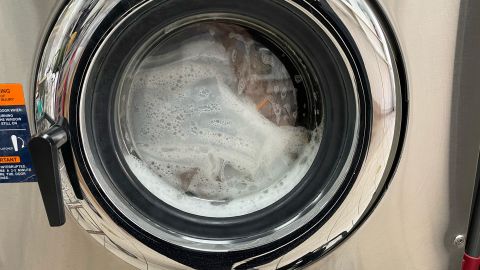
Research shows that natural fibers like cotton, wool and silk also shed fibers and cause harm to aquatic organisms, but Browne’s water samples found 170% more microplastic fibers than natural fibers, hence the focus on reducing synthetic pollution. One of the issues with washing bags is that they put the onus on individuals to resolve issues that government regulations, washing machine manufacturers and textile producers are responsible for preventing. “The further you get away from the source of the problem, the more difficulty you have mitigating it,” Browne concludes. He recommends a shift toward wearing more durable and less toxic clothing.
The findings of Browne’s research on microplastic fiber filters have not yet been published, but what we know is that cutting down on fabric shedding helps your clothes last longer, keeping their fibers intact and out of the oceans — for that, the Guppyfriend bag is a useful household tool.
According to Guppyfriend co-founder Alexander Nolte, the bags sold in Europe are made under fair European labor practices in factories that he and his team visit regularly. Like many patented brands, Guppyfriend does not publish the certifications of its manufacturing partners publicly. However, upon request, Laass provided documentation of recent independent audits and certifications to verify fair and safe labor conditions in their factories.
Guppyfriend’s textiles, which come from Italy and Portugal, are certified nontoxic by Okeo-Tex. The bag’s materials are sewn together in Portugal and Poland at factories that adhere to ISO9001 quality management standards and use the HIGG Index for facility sustainability and labor assessment.
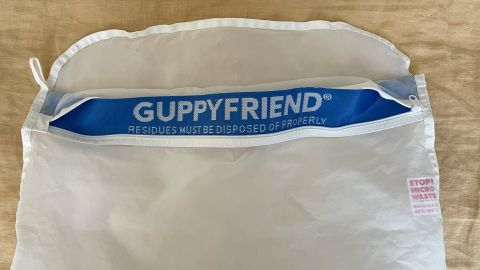
As for Japanese, Australian and US customers, Guppyfriend bags are sewn in factories that are located either in Europe or China. The latter of which are certified by FSC (Forest Stewardship Council), GOTS (Global Organic Textile Standard), and Germany’s government-run Green Button program for ethical labor and environmentally sustainable practices along the entire supply chain. The Chinese factories are also compliant with BSCI (Business for Social Compliance Initiative) and undergo routine audits.
Scientific research takes years to reach bold conclusions, and policy makers are slow to enact change at the manufacturing level, but there are meaningful actions you can take to reduce microplastic and microfiber debris. It all starts with your habits: Buy fewer and higher quality clothes, launder less and protect your clothes from shedding in the wash.
For the synthetics you already have, the Guppyfriend Washing Bag is an effective tool to protect clothes from abrasion and is a reminder to reduce the spread of microplastics within and beyond your home. In our testing, the Guppyfriend did catch microplastic fibers, but change is needed across the textile industry to substantially reduce microplastic pollution. The quality of the bag is impressive and when its lifespan ends, the bag is fully recyclable without the zipper. Bonus: Washing laundry in this bag has a built-in reminder to hang dry, not heat dry, your synthetic garments in order to reduce microplastic pollution in the airways as well as waterways.




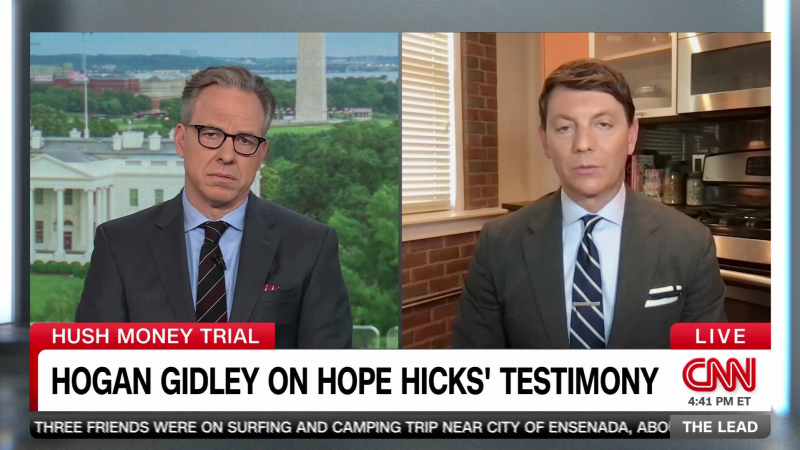
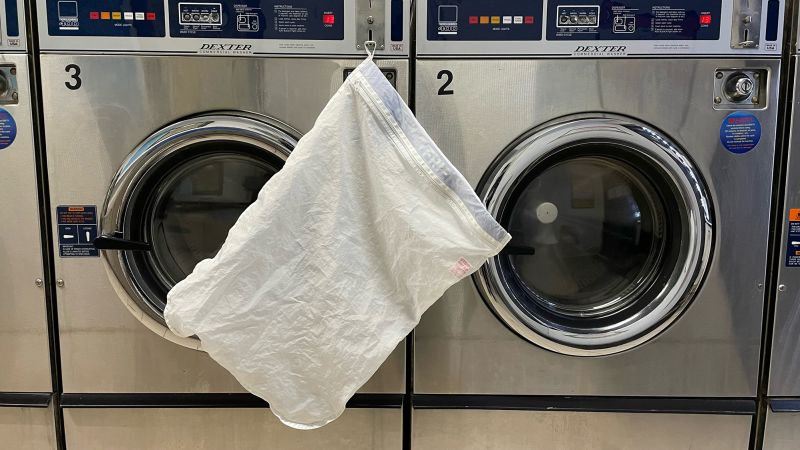
More News
Inside the White House Scramble to Broker a Deal in Gaza
Opinion | Senators Need to Stop the Anti-Semitism Awareness Act
Timeline of Recent Twists and Turns in Gaza Cease-fire Talks